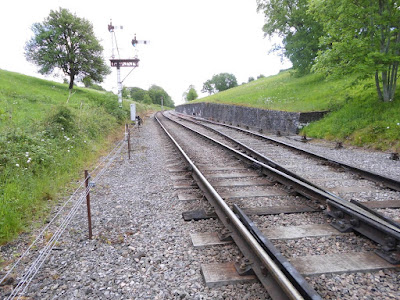Saturday 25 May
Misleading title today, although being at Stanton gave us an exclusive view of the engines out for the 2019 Cotswold Festival of Steam.
 |
LNER B1 1264 on holiday from
the North Yorkshire Moors Railway |
Today we started on the new build of the up side cess outfall headwall and the rebuild of the gully under Bridge 11. To add a bit of interest, the remnants of the old up side ballast retaining wall from the south end of the viaduct met the fate of life expired block work. This lump of block was inadvertently reported in the last blog as being from the aqueduct, apologies must go to the water over rail bridge community 😉
 |
| The ballast wall remains before |
 |
| Dave left to pick up the pieces |
Meanwhile down at the up side cess outfall, Roger and Alastair were busy...
 |
| First course of brick going down |
 |
Roger doing something with the spirit level 😊
(Photo: Alastair) |
 |
| Just one Cornetto... the sunshade is for the mortar |
Later in the day.
 |
| Progress upwards |
The gully drain sub-group made equally good progress, starting with correcting the level of the trench for the gully pipe.
 |
| Michael shaving a few cm off the base |
 |
| Top courses of bricks off the silt trap |
While clearing the remaining debris out of the slit trap we probed to see if there is a concrete base, the bar went in 450 mm without hitting anything solid. We will drop a dry concrete mix in to remedy this.
 |
| Nothing solid in the bottom |
 |
| Pipe cut to length and dropped in |
A flow test was conducted on the pipe, just to be sure there were no uphill sections.
 |
| Outlet pipe flow test passed |
Next stage is the rebuild, with the pipe to fix and then the silt trap to rebuild
 |
| Michael concretes the pipe in |
 |
Getting it level
(Photo: Alastair) |
After over 100 years service, with possibly the last 50 years being buried, the old cast gully heads off to the recycling skip
 |
| Like many centenarians, there's a few missing teeth 😉 |
Alastair and Stuart managed a bit of fire fighting for a little bit of added excitement this afternoon; just after the B1 had passed, smoke was spotted rising from the down side cess. So the intrepid duo sprang into action and extinguished the blaze small area of smouldering grass.
 |
| Alastair tramples out the last of the ashes |
Visible progress today by packing up time; down under the bridge and up at the cess outfall.
 |
| Wrapping up the gully drain until next week |
 |
| Starting to look like a headwall |
One last job before we left was to peg out the site for the hard standing and turn round area, the grass is suitable if the weather stays fine, but if we do get some rain we will have to go down to the crossing to turn the truck. A hard standing allows us to turn in safety and park away from the track.
 |
Dave doing the honours
(Photo: Alastair) |
 |
| Contractors will be arriving to level the area next week |
 |
| Roger testing that the measurements are correct |
It's often hard to imagine how much water our culverts have to cope with, Alastair has been into his archive and found these images from 2012 (Just 5 years after the 2007 floods), so hardly a 1 in 100 years event.
 |
Culvert 11A and down side cess meet
(Photo: Alastair) |
 |
Culvert 11A up side - the scour is evident
(Photo: Alastair) |
A question about our Thursday blog prompted more explanation. Here's the map we use to see if we can sort out what has happened over the years. It looked like a siphon culvert north of Springfield Land at Broadway that was discovered. We can only guess about the location of the culvert outlet, this part of the trackbed isn't GWSR land but we will still try and get the covers made safe.
The left hand map is the area pre-railway, the right is up to date. The old map shows 2 springs (each end of the blue arrow on both maps). The red arrow points to the current start of a visible ditch, the dashed green line shows the cess drain run from the station. From this we assume that the siphon is piped under the field an under the bypass (A44) before opening into a ditch again. The flow in the cess is less than the stream flow, so it isn't going into the cess. The assumption may be wrong, but further investigation is way down the priority list.
That's it for this week, just a last view from our ring side seats at the Cotswold Festival of Steam.
 |
| GWR 2-8-0T 4270 rumbles past this afternoon - another centenarian |

































































